| << Previous (Linear) | (Applications) Next >> |
ST7-R3.20 Nonlinear |
||
|---|---|---|
| ST7-R3.20.10 Nonlinear / Statics | ||
|
1.1 MB |
ST7-R3.20.10.1 Nonlinear Elastic and Inelastic Buckling of a Column This Webnote covers the following topics:
|
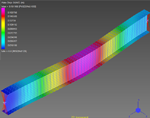
|
|
0.6 MB |
ST7-R3.20.10.2 Nonlinear Analysis Basics This Webnote presents an overview of some of the basic concepts of nonlinear analysis, including iteration, load increments (or load steps), convergence and residual forces. Most nonlinear problems are solved by an iterative numerical procedure that needs to converge before the results can be accepted. Not all nonlinear problems are guaranteed to converge. However, convergence can often be improved by adjusting some of the solver parameters, depending on the model, the loads, and so on. Non-convergence can occur when attempting to solve for a physically impossible situation, or when the nonlinear solution algorithm is not sufficiently robust to solve a difficult nonlinear problem. |
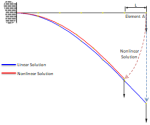
|
|
0.7 MB |
ST7-R3.20.10.3 Defining Nonlinear Static Load Increments Load in the Nonlinear Static solver is applied by defining a load increment (or load step) table. This table comprises one or more increments - these are the columns in the table. Each increment defines the total load to be applied by assigning factors to the load and freedom cases in the model - these are the rows in the table. Effectively, each increment defines a combination of load and restraint (or enforced displacement) to be applied at that step. |

|
|
0.9 MB |
ST7-R3.20.10.4 Determining the Onset of Buckling in a Nonlinear Static Analysis Nonlinear buckling analysis involves not only identification of the point at which buckling (structural instability) may be regarded as having occurred, but also the structural behaviour leading up to the instability, and often the structural behaviour beyond the instability. In contrast to linear buckling analysis, the result is not output explicitly as a buckling load factor. Instead, the structural response needs to be interpreted, typically by inspecting a graph of applied load vs displacement or other quantity. |
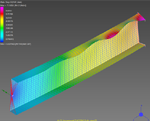
|
|
2.6 MB |
ST7-R3.20.10.5 Nonlinear Static Convergence This Webnote examines convergence in the nonlinear static solver, describes some of the common causes of convergence difficulties, and summarises tools and techniques to help improve convergence. |

|
|
0.3 MB |
ST7-R3.20.10.9 The Nonlinear Convergence Graph This Webnote examines the nonlinear convergence graph available in the nonlinear solver window and nonlinear solver log file viewer. The graph is the visual representation of the solver convergence history, and is produced by all of the nonlinear solvers. |

|
| ST7-R3.20.20 Nonlinear / Dynamics | ||
|
1.9 MB |
ST7-R3.20.20.1 Modelling the Impact of a Mass on a Plate This Webnote outlines the procedure to model a moving mass impacting on a flat plate. The analysis considers geometric nonlinearity, with and without material nonlinearity. Deflections, stresses and reactions during and after impact are extracted from the analysis. |

|
|
23.4 MB |
ST7-R3.20.20.2 Modelling the Impact of a Mass on a Tube This Webnote outlines the steps required to model dynamic impact of a mass with a metallic tube. The modelling is only concerned with the behaviour of the impacted structure, and as such the mass is modelled as a rigid body. |
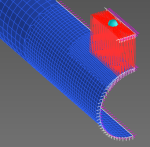
|
|
1.5 MB |
ST7-R3.20.20.3 Frame Dynamic Yielding and Static Pushover This Webnote examines a 2D frame subjected to a seismic time history base excitation. Static pushover analysis is also performed to study the static capacity of the structure. Parameter sensitivity studies are then conducted. |

|
|
1.0 MB |
ST7-R3.20.20.4 Transient Dynamic Analysis Time Stepping This Webnote discusses the selection and assessment of the time step for the Linear and Nonlinear Transient Dynamic solvers. |

|
|
0.7 MB |
ST7-R3.20.20.5 Modelling a Simple Double Pendulum Strand7 can model kinematic motion with the Nonlinear Transient Dynamic solver. This Webnote uses a model of a simple double pendulum to describe a procedure that can be extended to simulate more complex mechanisms. |

|
|
0.5 MB |
ST7-R3.20.20.6 Using the Equation Editor to Define Factor vs Time Tables This Webnote uses the Equation Editor to define Factor vs Time tables. The Equation Editor is a powerful tool when creating time histories based on equations. It offers the flexibility of defining tables in segments, using multiple equations in sequence. |
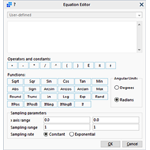
|
| << Previous (Linear) | (Applications) Next >> |

 Menu
Menu